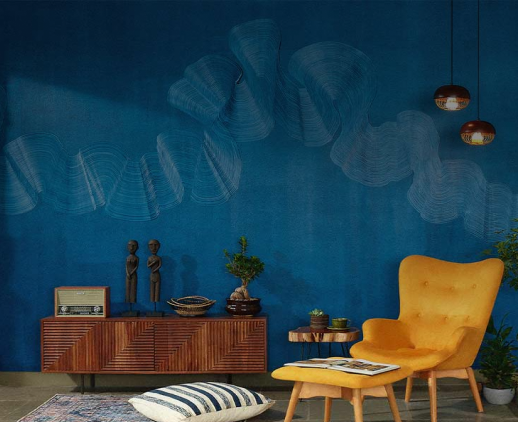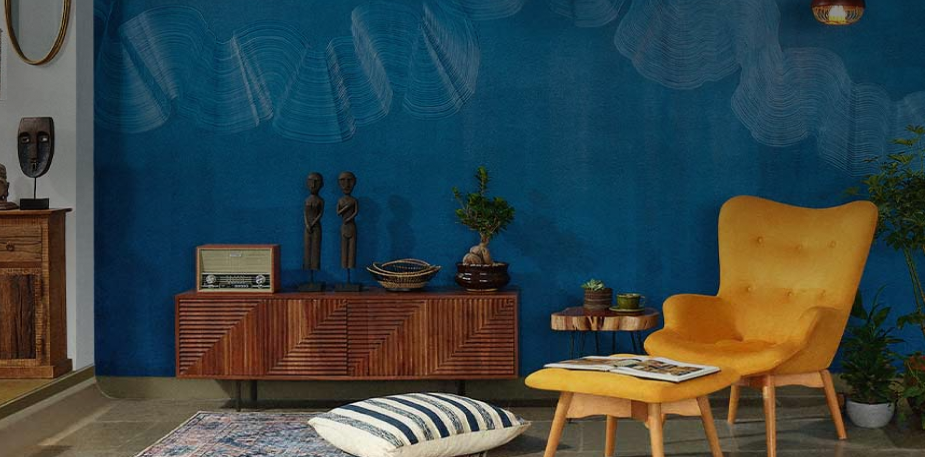Get your home interior design budget estimate
A terrace flat in Mumbai celebrates nature and brings out a modern Indian aesthetic

Architect Amritha Karnakar’s home is designed to be nature’s nest with a modern vibe punctuated with a love for all things Indian
Childhood homes invoke a lot of things—memories, a deep sense of nostalgia, one's own evolution through the years and the home's changes to along with it. Architect Amritha Karnakar's Andheri home is one better. It is a canvas for her parents' creativity reflected in its design iterations through the years—and, as Karnakar says, a source of inspiration for her design sensibilities as well. "When we look at old photos [of the house], it's amazing how different it used to look back then. I have seen it change in terms of design and aesthetics, first by my parents and eventually by me, to transform it to this state," says Karnakar, who began her design firm AKAD (Amritha Karnakar Architectural Design) back in 2010.
A two-bedroom house with an attached terrace in Mumbai's choc-a-bloc suburb Andheri is a rarity of the best sort, and Karnakar and her parents before her have a lot to do with it. And that began with the layout. "The living room and dining room overlooks the terrace. The all-glass window brings in a lot of natural light into these spaces," explains Karnakar about this home that was bought around 35 years ago.
It's a Jungle Out There
The uninterrupted run from the indoors to the outdoors speaks eloquently of the design philosophy this Mumbai-based architect follows, where architecture, interiors and landscaping all go hand in hand. That approach dovetails with the design maxim of the legendary Sri Lankan architect Geoffrey Bawa, who is a constant source of inspiration. "He blurred the lines of inside and outside of a home with such finesse. Every corner of a house, may it be the living room or a bathroom must have its own special opening to a green outer space."
True to form, therefore, is a terrace overflowing with a variety of flora. "Our home represents our love for all things Indian made, our love for travel and obsession for plants."

Overview of the terrace with a jungle of fruiting, flowering plants, bonsai, orchids and palms.
This veritable oasis, Karnakar says, predates her entry into this world. "The terrace has been developed over 35 years from a bland empty terrace to a full bloom jungle. Every single plant has been nurtured by my parents as their babies. We have everything, from huge trees to an array of bonsai, unique orchids, fruiting and flowering plants."

The living room overlooks the terrace, blending the indoors with the outdoors.
Indian at Heart
The overflowing greenery outside flows into interiors that reflect Karnakar's abiding love for Indian arts and craft—and her south Indian roots. The uninhibited growth of plants on the terrace outside offsets the interiors, with its well-curated and well-placed curios and furniture and earthy tones framed by carved wooden beams and columns. The warmth of the space comes through with the wooden pieces and brass detailing, a lot of which Karnakar used in unconventional ways. "We have carved antique doors from Rajasthan used as a centre table", and brass-etched pots from north India double up as side tables.
Anchoring the space further into the modern India aesthetic are stone sculptures from Hampi and Rajasthan. All of it comes together to narrate the story of its homeowners. "Every piece of artefact in our house has a story to tell about our travels.
And none of it overpowers the calm, cool elegance that is inherent to the space, with the earthy tones used within, blending with the terrace greenery outside and the light, white palette on the walls and the white Indian marble floor, which is an elegant counterpoint.
This is a space that offers an ideal amalgamation of a contemporary aesthetic underpinned by decidedly Indian accents with nature playing a starring role. For Karnakar, this home, apart from her parents, deserves the "credit for making me the designer I am today".

Get Started with your interior design journey with us!
Speak to our design professionals
What’s the status of your home possession?
What’s the condition of your home/space?
Will you be living in your space during the renovation?
 Previous Question
Previous Question
Is your interior design budget over 4 lakhs?
 Previous Question
Previous Question
Book next available appointment slots with our experts!
Please Select Date and Day
 Previous Question
Previous Question

Something went wrong!
We were unable to receive your details. Please try submitting them again.

Appointment Scheduled!
Thank you for giving an opportunity to Asian Paints Beautiful Homes Service! Our Customer Experience Specialist will get in touch with you soon.
Appointment Date & time
Thank You!
Our team will contact you for further details.
What’s the status of your home possession?
What’s the condition of your home/space?
Will you be living in your space during the renovation ?
 Previous Question
Previous Question
Is your interior design budget over 4 lakhs?
 Previous Question
Previous Question
Book next available appointment slots with our experts!
DEC 2023
Please Select Date and Day
 Previous Question
Previous Question

Something went wrong!
We were unable to receive your details. Please try submitting them again.

Appointment Scheduled!
Thank you for giving an opportunity to Asian Paints Beautiful Homes Service! Our Customer Experience Specialist will get in touch with you soon.
Appointment Date & time
17 Oct 23, 03.00PM - 04.00PM















































